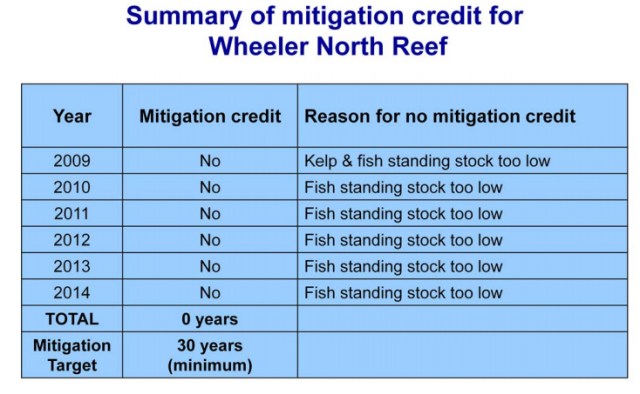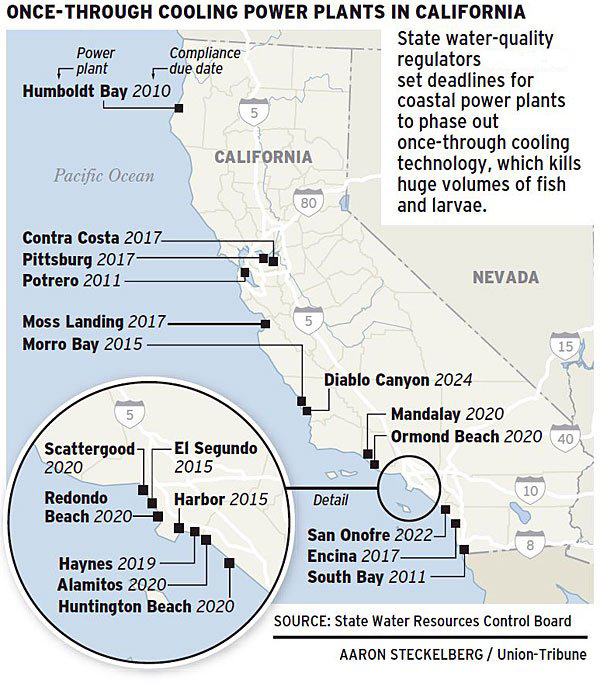The San Onofre and Diablo Canyon nuclear reactors kill and maim millions of fish and other marine life every year, and damage the ecosystem − more than all other California once-through cooling system power plants.
They are among the worst in the nation. See Sierra Club Giant Fish Blenders July 2011. Federal Clean Water Act §316(b) regulations ban once-through cooling.
NRC: U.S. Nuclear Power Plant cooling systems (NUREG-1437).
Numerous state agencies have jurisdiction to deny operating permits to California’s nuclear power plants.
California Coastal Commission (CCC)
- All voting Coastal Commissioners are appointed either by the Governor, Senate Rules Committee, or the Speaker of the Assembly; each appoints four commissioners, two public members and two elected officials.
- The California Coastal Commission issued a coastal development permit for reactor Units 2 and 3, allowing San Onfore to be built by the ocean in Southern California.
- A condition of the permit required study of the impacts of the operation of the nuclear reactors on the marine environment offshore from San Onofre, and mitigation of any adverse impacts. Permit No. 6-81-330-A requires Southern California Edison (SCE) to design and build mitigation projects that adequately compensate for the adverse effects of the power plant’s once-through seawater cooling system on coastal marine resources.
- The mitigation reef project has NOT been successful at mitigating the damage caused by San Onofre. See UCSB San Onofre Mitigation Monitoring website.

U.C. Santa Barbara 2014 Mitigation Program Annual Status Report
- Long-term monitoring and evaluation of the San Onofre mitigation projects is a condition of the coastal development permit. See 2012 Mitigation Program Annual Status Report and 2014 Mitigation Program Annual Status Report. UCSB San Onofre Mitigation Monitoring website.
 University of California Santa Barbara (UCSB) scientists working under the direction of the Executive Director of the CCC are responsible for designing and implementing monitoring programs aimed at determining the effectiveness of these mitigation projects at a cost to ratepayers of approximately $1 million annually. The San Onofre Mitigation Monitoring Program is based at the Marine Science Institute, University of California Santa Barbara.
University of California Santa Barbara (UCSB) scientists working under the direction of the Executive Director of the CCC are responsible for designing and implementing monitoring programs aimed at determining the effectiveness of these mitigation projects at a cost to ratepayers of approximately $1 million annually. The San Onofre Mitigation Monitoring Program is based at the Marine Science Institute, University of California Santa Barbara.
California Public Utilities Commission (CPUC)
- Annual Funding for the San Onofre (SONGS) Mitigation Monitoring Program is provided by SCE (paid by ratepayers) as a requirement of their coastal development permit for operating San Onofre. The UCSB portion of the costs is approximately $1 million annually.
- The California Public Utilities Commission approves charges to ratepayers. They also determine if the plant is cost-effective and reliable for ratepayers and California.
- Click here to find documents on CPUC’s proceedings search webpage. Enter “onofre” in the Description Search box.
State Water Resources Control Board (SWRCB)
- California’s State Water Resources Control Board is responsible for implementing the Federal Clean Water Act §316(b) regulations on cooling water intake structures. However, they have delayed implementation, resulting in the death of more marine life, including California Sea Lions.
- Large Organism Exclusion Device (LOED) Project, April 28, 2016, to prevent large marine mammals (e.g., California sea lions and other large aquatic organisms (e.g., green sea turtles, black seabass,large white sea bass, from entering the cooling water intake structures, to prevent injury or mortality.
- June 18, 2013 SWRCB Public Hearing. Comment deadline is June 4, 2013 by 12 noon. The Board will hold a public hearing to receive public comment on a proposed amendment to the Water Quality Control Policy on the Use of Coastal and Estuarine Waters for Power Plant Cooling. The Board will consider adoption of the proposed amendments following the hearing. Location: Joe Serna Jr. Cal/EPA Headquarters Building, Coastal Hearing Room, 1001 I Street, 2nd floor, Sacramento, CA 95814.
- If the WRCB enforced compliance, the costs would be prohibitive, resulting in the probable shutdown of San Onofre. Some reports have been done regarding cost to retrofit San Onofre and more are being done.
- Edison estimates $2.5 billion to retrofit San Onofre — NC Times 8/8/2009
- Edison Feasibility Study for Installation of Cooling Towers at San Onofre 9/18/2009: Estimated initial costs of more than $3 billion, and annual costs of $85 million.
- SWRCB Alternative Cooling System Analysis for San Onofre 2/27/2008: Estimated capital and start-up costs of $593.1 million; all capital costs, operation and maintenance costs, and energy penalty costs over 20 years, discounted at 7.0% totals $2.62 billion.
- NOTE: New Jersey’s Oyster Creek nuclear plant is closing due to the expense of complying with their once-through cooling rules.
- SWRCB Once-Through Cooling policy and status links:
- Review Committee for Nuclear Fueled Power Plants
- Once-through Cooling Policy Fact Sheet
- OTC Nuclear Power Plants Worst Damage to Marine Life Chart
- Once-through Cooling Water Use and CWA 316(b) Regulation
- Amended Policy 7/19/2011
- Federal Water Pollution Control Act
- Water Quality Control Policy on the Use of Coastal and Estuarine Waters for Power Plant Cooling, Final Substitute Environmental Document SWRCB/CEPA 5/4/2010
- SWRCB Map of OTC Plants affected
- California OTC plants affected – SWRCB website
- EPA Fact Sheet for Proposed Regulations for Cooling Water Intake Structures
- EPA website for Cooling Water Intake Structures—CWA §316(b)
- State Water Resources Control Board Calendar
California Independent System Operator (CAISO)
- The California Independent System Operator’s annual transmission planning process is evaluating potential reliability impacts caused by retiring California once-through cooling gas plants and nuclear power reactors, the off line time needed to retrofit them with alternative technologies, as well as the timing issues of when plants will implement their compliance strategies (2012-2020).
- Currently, the state’s plan is to shut down the once-through cooling gas plants first. They do not have a plan in place to shut down the nuclear plants. See CAISO Once-through cooling generation.
California State Lands Commission (CSLC)
- The California State Lands Commission is an independent body, composed of three members—the Lieutenant Governor and State Controller, both statewide elected officials, and the Director of Finance, an appointee of the Governor. The CSLC has the authority and responsibility to manage and protect the natural and cultural resources on certain public lands within the state and the public’s rights to access these lands. The public lands under the Commission’s jurisdiction are of two distinct types—sovereign and school lands. Sovereign lands encompass approximately 4 million acres. These lands include the beds of California’s naturally navigable rivers, lakes and streams, as well as the state’s tide and submerged lands along the state’s more than 1,100 miles of coastline, extending from the shoreline out to three miles offshore. In short, the CSLC’s jurisdiction extends to more than 120 rivers and sloughs, 40 lakes and the state’s coastal waters. See State Lands brochure for details.
- The Commission leases sovereign lands for public trust purpose, and is often called upon to prioritize competing trust values in deciding whether to issue a lease for a proposed project. Commission leases of sovereign lands generally fall into several categories: recreational, commercial, industrial, right-of-way, and salvage. Specific examples of such leases include private recreational piers, commercial marinas, yacht clubs, marine terminals, industrial wharves, oil and gas pipelines, fiber optic cables, outfalls, bank stabilization, and wetlands and habitat management projects.
- San Onofre has leases with the State Lands Commission. One is for the coastal area used by the OTC intake system. The SWRCB required San Onofre to implement large organism exclusion device protection. This required approval from the State Lands Commission:
- San Onofre Large Organism Exclusion Device Marine Mammal Monitoring and Protection Plan 8/6/2012
- Revision of Rent and Lease amendment 10/19/2012: Approve the revision of rent for Lease No. 6785.1 from $88,316 per year to $151,275 per year, effective March 1, 2013. Authorize the Amendment of Lease No. PRC 6785.1, a General Lease – Industrial Use, effective October 19, 2012, to amend the Land Use or Purpose and Special Conditions to include the installation, use, and maintenance of two Large Organism Exclusion Devices on the primary offshore intake structures of Units 2 and 3; and dredging as described in Exhibit A and shown on Exhibit B (for reference purposes only); and liability insurance in the amount of $5,000,000; Lessee may satisfy all or part of the insurance requirements through maintenance of a self insurance program as outlined in the lease; lessee shall comply with all provisions of the Mitigation Monitoring Program as contained in Exhibit C, attached hereto; and all other terms and conditions of the lease as previously amended will remain in effect without amendment. Further approvals required:
- California Coastal Commission
- California Department of Fish and Game
- San Diego Regional Water Quality Control Board
- U.S. Army Corps of Engineers
- U.S. Coast Guard U.S. Fish and Wildlife Service
- National Oceanic and Atmospheric Administration
- Fisheries Service
Power plants face closures – UTSanDiego 5/11/2010
Background
Many of California’s coastal and bay-side power plants use an antiquated cooling technology that sucks in over 16 billion gallons of cold seawater per day to cool plant operations. The State Water Board estimates that the plants’ cooling systems kill billions of marine species unlucky enough to be near the intake pipes each year. This “once-through cooling” (OTC) process draws fish, larvae, plankton, and other marine life into the plant, and kills and injures larger marine species such as sea lions and turtles on the intake screens. The plants also pump the heated water back into the delicate coastal and Delta ecosystems, many of which serve as nurseries for marine life. This outdated technology dramatically impacts the health of our ocean.








Pingback: 04/17/2013 WRCB meeting: Once-through cooling nuclear reactors | San Onofre Safety